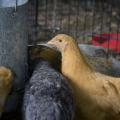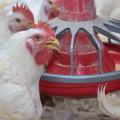4-H Poultry Production & Records
Poultry production consists of a series of poultry care and management projects designed and coordinated to the 4-Her's increasing knowledge and acceptance of responsibility for the care of live birds. The various units address topics related to brooding, feeding and general care of chicks; the management of an egg laying flock; consumer education and marketing of poultry products; selection, breeding and exhibition of pure breed birds; broiler and turkey production; and maintenance of production and financial records.
The units are coordinated and designed to be conducted in sequential order because they get progressively more demanding. However, each project is largely independent of all others and may be conducted as a separate challenge. Each project is listed below and is followed by a brief description.
Unit 1 -- Brooding and Raising Chicks
The goal of this unit is to brood and raise a flock of chicks. The 4-Her begins with a recommended flock of 50 chicks during the first year and increases the number to 200 birds during the third year. The breeds of chickens vary each year to expose the 4-Her to different types of birds and challenges. Approximately one-half the flock will be roosters that can be slaughtered and used at home for meat. The best pullets are retained as a laying flock for egg production.
Unit 2 -- Laying Flock Management
This unit is designed as an extension of Unit 1. The management of pullets increases from a flock of 25 hens during the first year to a flock of 100 hens or more during the third year. Two methods for obtaining birds are:
- Save pullets from Unit 1
- Buy started pullets from a supplier.
In this unit a 4-H member could take over the management of the home flock. If properly managed, the flock will furnish all the eggs the family can use. With 25 or more hens there will be eggs available for sale.
Unit 3 -- Flock Management and Marketing
After the third year, if successfully managed, the project can show a good profit. This unit is an extension of Unit 2 by increasing the flock size and marketing of the eggs. The 4-H member begins with 100 hens during the first year and increases to 500 or more during the third year. Some 4-Hers may decide to increase the project to 1,000 laying hens or more.
Two methods of getting birds are:
- Brood and raise a flock of sexed pullets
- Buy started pullets (18-20 weeks of age).
If the 4-H member's parents have a commercial laying flock, an arrangement can be made for the youth to accept certain responsibilities to manage the flock. The arrangement can include a percentage of the profits for the club member. This has worked successfully in many 4-H poultry projects in the past.
The key objective of this unit is related to the development of an egg market (customers) and supplying them with ample, high-quality, graded eggs. The project is much more than managing birds and producing eggs.
Unit 4 -- Producing Broilers
This broiler project works well with 4-H members whose parents grow broilers commercially. An arrangement can be made for the youth to accept certain responsibilities for managing the broiler flock. The arrangement can include a percentage of the profits for the member. Many 4-H members in the past have had successful projects with similar arrangements.
Unit 5 -- Turkey Production
Although turkeys are not commonly produced in Mississippi, the 4-H youth can profitably raise a small flock for satisfying local demands during the holiday seasons. During the first year the 4-Her can raise and market 25 turkeys and increase production until during the third year, 100 or more turkeys can be raised and marketed.
The turkey poults (hatchlings) are purchased during spring months (May through July) and raised during the summer and early autumn. Prior to the Thanksgiving or Christmas holidays the turkeys are slaughtered, processed, and marketed to local markets.
Unit 6 -- Marketing and Consumer Education
This unit coordinates well with the other units. In this unit club members learn to market and promote poultry and eggs. This is done by demonstrations, exhibits and talks.
Unit 7 -- Raising, Breeding and Exhibiting Show Birds
This project challenges 4-H members and adults. In this project, the 4-H member has the opportunity to:
- Own and work with live poultry;
- Acquire experience and knowledge of poultry breeding, incubation, brooding and rearing;
- Train and prepare birds for shows and exhibits;
- Learn principles of poultry management;
- Get experience in keeping records;
- Participate in the total 4-H Club Program.
The 4-Her is required to own and care for one male and two females of any breed and variety of birds listed in the American Standard of Perfection, including Bantams. This is a
minimum requirement for all breeds and varieties. The project is maintained throughout the year. Exhibiting at poultry shows is not required, but exhibiting at local and county shows is encouraged. The maintenance of accurate records is an important requirement
Club and Leader Activities
An exhibit is one of the requirements of a Standard Club. The 4-H exhibit visualizes the accumulated results of the Club's work. It gives an opportunity for comparison and improvements and new ideas. Exhibits of poultry will do much to broaden the field of activity of 4-H poultry members. Poultry exhibits at county fairs may include:
- Exhibition Class - singles or trios of show birds (Unit 7)
- Production Class - singles or trios of production pullets or hens
- Meat Class - singles or trios of any meat strain of bird
- 4-H Poultry Chain - 6 to 12 bird pens (based on chicks started)
Record keeping is an important phase of all 4-H poultry programs. All 4-H members are encouraged to keep accurate records. Refer to MCES Publication 255 and MCES Publication 743 for 4-H Club Member's Record Forms. Suggested records to keep include:
- Monthly 4-H Poultry Record (MCES Form 183)
- Yearly 4-H Poultry Record (MCES For 184)
- 4-H Project Record Sheet (MCES Form 90 or Form 296)
- Standard Report Forms
- Pictures of project, judging team, contests and other events related to the poultryproject
- Newspaper clippings of anything dealing with the project or 4-H activities
One of the most helpful activities as a leader is visiting each member's poultry project. No matter how well informed the parents may be, a visit will help stimulate interest in the project. When visiting, a simple checklist or score sheet helps emphasize important management and marketing factors. A suggested check list includes:
- Are records kept updated?
- Is sanitation and management acceptable?
- Are events and activities known by all involved?
Publications
News
Farm supply stores are full of cute chicks in the spring, and the sight of the fluffy baby birds, combined with future dreams of fresh eggs, prompts many people to impulsively start a backyard flock.
STARKVILLE, Miss. -- Keeping buffalo wings on menus is a supply chain issue that goes all the way back to procedures farm workers follow to protect the health of commercially grown chickens.
Baby chickens are so cute and cuddly that few people can resist holding them. Unfortunately, as public interest in raising backyard birds has grown so has the number of Salmonella outbreaks in the U.S. (Photo by Centers for Disease Control and Prevention)







